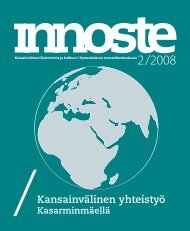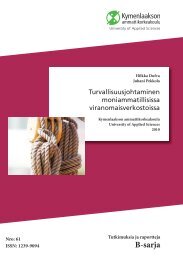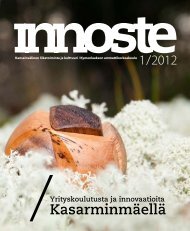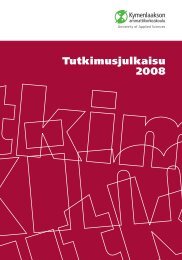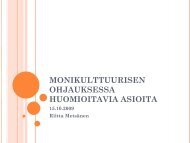Pdf-muodossa - Kymenlaakson ammattikorkeakoulu
Pdf-muodossa - Kymenlaakson ammattikorkeakoulu
Pdf-muodossa - Kymenlaakson ammattikorkeakoulu
You also want an ePaper? Increase the reach of your titles
YUMPU automatically turns print PDFs into web optimized ePapers that Google loves.
usiness schools respectable academic underpinnings and offered grant money<br />
toward achieving that end. Driven by conscience and cash, top-tier universities<br />
began to treat their business schools almost as seriously as law schools. By the end<br />
of the twentieth century, nearly all the nation’s leading business schools – the two<br />
dozen or so elite MBA-granting institutions and another dozen schools fighting<br />
to join the highest echelon – offered a curriculum of academic distinction. But, in<br />
the process, their focus switched, and now the objective of most business schools<br />
is to conduct scientific research (Ibid.).<br />
European business schools were, and still are, heavily influenced by their US peers.<br />
It is enough perhaps to remember the MBA frenzy of the 1990s when MBA programmes<br />
were introduced by most major business schools in Finland. It is not<br />
only the MBA programmes whose curriculum and main actors are in question.<br />
The problem seems to be in the relevance of available and offered business education<br />
to its main consumers: students and businesses. The backbone of business<br />
education could be summarised in who does what thus narrowing the problem<br />
area to the academic personnel that is involved in teaching and the academic<br />
curriculum.<br />
2.1. Lecturers<br />
A key player in the learning process at any business school is the academic personnel<br />
in general and particularly lecturers. That will mean that the quality of academic<br />
personnel is of upmost value, especially since often it is the lecturers that<br />
will determine the academic curriculum and course content. Thus the selection<br />
criteria when choosing academic personnel appears to crucial. It is a cold fact of<br />
life that getting an academic position in most business schools is directly linked<br />
with the publishing record of the applicant measured not only in quantity but also<br />
in quality (Frey, 2004). With different variations in job description requirements<br />
that aim to diversify the expected skills and knowledge, at the end of the day it is<br />
ones publishing record that matters.<br />
52<br />
Such selection criteria have a tremendous impact on the way and thinking and career<br />
construct for academic personnel that boils down to the US originating slogan<br />
“publish or perish”. It could be laughed of as pathetic if it were not taken by academic<br />
scholars totally seriously. As a result all energy is focused and invested on<br />
publishing in “good” journals, which is a world in itself. Quoting people from the<br />
targeted journal editorial board is recognised if not an openly acclaimed strategy.<br />
Getting into an editorial board is thus considered important advancement in ones<br />
academic career. Other ingredients of the fine art of publishing include extensive<br />
quoting of recognised authors and basically imitating their style and reasoning.<br />
Most importantly one must definitely try to contribute towards better theoretical<br />
understanding. One example could be the impact of research in entrepreneurship<br />
for business and policy makers. There are numerous indications that such research<br />
does ”Nothing much, really” - the suggested reason is partly an inability of<br />
researchers to address the most relevant issues and to present their findings in a<br />
form and place that reach practitioners (Davidsson, 2002).



